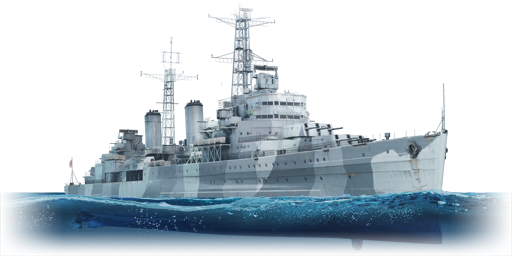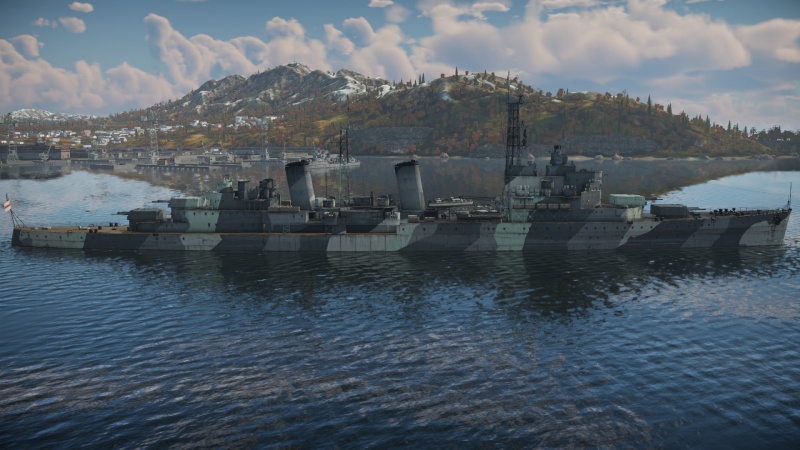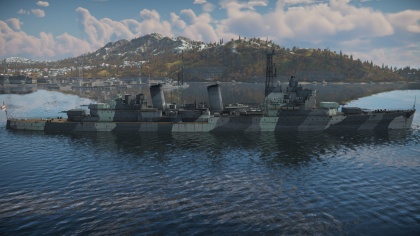Difference between revisions of "HMS Belfast"
(→Usage in battles: Added modules) |
|||
| Line 1: | Line 1: | ||
| − | {{Specs-Card|code=uk_cruiser_belfast}} | + | {{Specs-Card |
| + | |code=uk_cruiser_belfast | ||
| + | |images={{Specs-Card-Image|GarageImage_{{PAGENAME}}.jpg}} | ||
| + | }} | ||
== Description == | == Description == | ||
| Line 53: | Line 56: | ||
=== Survivability and armour === | === Survivability and armour === | ||
| + | {{Specs-Fleet-Armour}} | ||
''Talk about the vehicle's armour. Note the most well-defended and most vulnerable zones, e.g. the ammo magazine. Evaluate the composition of components and assemblies responsible for movement and manoeuvrability. Evaluate the survivability of the primary and secondary armaments separately. Don't forget to mention the size of the crew, which plays an important role in fleet mechanics. Save tips on preserving survivability for the "Usage in battles" section. If necessary, use a graphical template to show the most well-protected or most vulnerable points in the armour.'' | ''Talk about the vehicle's armour. Note the most well-defended and most vulnerable zones, e.g. the ammo magazine. Evaluate the composition of components and assemblies responsible for movement and manoeuvrability. Evaluate the survivability of the primary and secondary armaments separately. Don't forget to mention the size of the crew, which plays an important role in fleet mechanics. Save tips on preserving survivability for the "Usage in battles" section. If necessary, use a graphical template to show the most well-protected or most vulnerable points in the armour.'' | ||
=== Mobility === | === Mobility === | ||
| + | {{Specs-Fleet-Mobility}} | ||
<!-- ''Write about the ship's mobility. Evaluate its power and manoeuvrability, rudder rerouting speed, stopping speed at full tilt, with its maximum forward and reverse speed.'' --> | <!-- ''Write about the ship's mobility. Evaluate its power and manoeuvrability, rudder rerouting speed, stopping speed at full tilt, with its maximum forward and reverse speed.'' --> | ||
The HMS Belfast has 80,000 shaft horsepower on its screws. This power is provided by four Admiralty oil-fired 3-drum boilers. The four propellers are driven by four Parsons single reduction geared steam turbines. This gives the Belfast a maximum forward speed of 32 knots (59 km/h). | The HMS Belfast has 80,000 shaft horsepower on its screws. This power is provided by four Admiralty oil-fired 3-drum boilers. The four propellers are driven by four Parsons single reduction geared steam turbines. This gives the Belfast a maximum forward speed of 32 knots (59 km/h). | ||
| + | |||
| + | === Modifications and economy === | ||
| + | {{Specs-Economy}} | ||
== Armament == | == Armament == | ||
| + | {{Specs-Fleet-Armaments}} | ||
=== Primary armament === | === Primary armament === | ||
| + | {{Specs-Fleet-Primary}} | ||
<!-- ''Provide information about the characteristics of the primary armament. Evaluate their efficacy in battle based on their reload speed, ballistics and the capacity of their shells. Add a link to the main article about the weapon: <code><nowiki>{{main|Weapon name (calibre)}}</nowiki></code>. Broadly describe the ammunition available for the primary armament, and provide recommendations on how to use it and which ammunition to choose.'' --> | <!-- ''Provide information about the characteristics of the primary armament. Evaluate their efficacy in battle based on their reload speed, ballistics and the capacity of their shells. Add a link to the main article about the weapon: <code><nowiki>{{main|Weapon name (calibre)}}</nowiki></code>. Broadly describe the ammunition available for the primary armament, and provide recommendations on how to use it and which ammunition to choose.'' --> | ||
{{main|6 inch/50 BL Mark XXIII (152 mm)}} | {{main|6 inch/50 BL Mark XXIII (152 mm)}} | ||
| Line 68: | Line 78: | ||
=== Secondary armament === | === Secondary armament === | ||
| + | {{Specs-Fleet-Secondary}} | ||
<!-- ''Some ships are fitted with weapons of various calibres. Secondary armaments are defined as weapons chosen with the control <code>Select secondary weapon</code>. Evaluate the secondary armaments and give advice on how to use them. Describe the ammunition available for the secondary armament. Provide recommendations on how to use them and which ammunition to choose. Remember that any anti-air armament, even heavy calibre weapons, belong in the next section. If there is no secondary armament, remove this section.'' --> | <!-- ''Some ships are fitted with weapons of various calibres. Secondary armaments are defined as weapons chosen with the control <code>Select secondary weapon</code>. Evaluate the secondary armaments and give advice on how to use them. Describe the ammunition available for the secondary armament. Provide recommendations on how to use them and which ammunition to choose. Remember that any anti-air armament, even heavy calibre weapons, belong in the next section. If there is no secondary armament, remove this section.'' --> | ||
{{main|4 inch/45 Mark XVI (102 mm)}} | {{main|4 inch/45 Mark XVI (102 mm)}} | ||
| Line 74: | Line 85: | ||
=== Anti-aircraft armament === | === Anti-aircraft armament === | ||
| + | {{Specs-Fleet-AA}} | ||
<!-- ''An important part of the ship's armament responsible for air defence. Anti-aircraft armament is defined by the weapon chosen with the control <code>Select anti-aircraft weapons</code>. Talk about the ship's anti-air cannons and machine guns, the number of guns and their positions, their effective range, and about their overall effectiveness – including against surface targets. If there are no anti-aircraft armaments, remove this section.'' --> | <!-- ''An important part of the ship's armament responsible for air defence. Anti-aircraft armament is defined by the weapon chosen with the control <code>Select anti-aircraft weapons</code>. Talk about the ship's anti-air cannons and machine guns, the number of guns and their positions, their effective range, and about their overall effectiveness – including against surface targets. If there are no anti-aircraft armaments, remove this section.'' --> | ||
{{main|QF Mark V (40 mm)}} | {{main|QF Mark V (40 mm)}} | ||
When fighting aircraft in the Belfast, you have both the secondary Ordnance QF 4 inch Mk XVI turrets and also 40 mm QF Mark V guns in six dual-mounted turrets. There is no ammunition you can select between, you will only get the default HE belt, but don't dismay, this belt is very effective when shooting down planes. | When fighting aircraft in the Belfast, you have both the secondary Ordnance QF 4 inch Mk XVI turrets and also 40 mm QF Mark V guns in six dual-mounted turrets. There is no ammunition you can select between, you will only get the default HE belt, but don't dismay, this belt is very effective when shooting down planes. | ||
| + | |||
| + | === Additional armament === | ||
| + | {{Specs-Fleet-Additional}} | ||
| + | ''Describe the available additional armaments of the ship: depth charges, mines, torpedoes. Talk about their positions, available ammunition and launch features such as dead zones of torpedoes.'' | ||
| + | |||
| + | ''If there is no additional armament, remove this section.'' | ||
== Usage in battles == | == Usage in battles == | ||
Revision as of 11:57, 29 December 2020
Contents
Description
The Town-class, HMS Belfast (C35), 1959 is a premium rank British light cruiser
with a battle rating of (AB), (RB), and (SB). It was introduced in Update 1.93 "Shark Attack".
General info
| Specification | Information |
|---|---|
| Crew (Complement): | 956 |
| Displacement: | 14,900 tons |
| Length: | 613 ft 6 in (186.99 m) overall |
| Beam: | 63 ft 4 in (19.3 m) |
| Draught: |
|
| Armour: |
|
| Installed power: | 80,000 shp (60,000 kW) |
| Propulsion: |
|
| Speed: | 32 knots (59 km/h) |
| Other: | Flagship of 10th Cruiser Squadron |
Survivability and armour
Talk about the vehicle's armour. Note the most well-defended and most vulnerable zones, e.g. the ammo magazine. Evaluate the composition of components and assemblies responsible for movement and manoeuvrability. Evaluate the survivability of the primary and secondary armaments separately. Don't forget to mention the size of the crew, which plays an important role in fleet mechanics. Save tips on preserving survivability for the "Usage in battles" section. If necessary, use a graphical template to show the most well-protected or most vulnerable points in the armour.
Mobility
The HMS Belfast has 80,000 shaft horsepower on its screws. This power is provided by four Admiralty oil-fired 3-drum boilers. The four propellers are driven by four Parsons single reduction geared steam turbines. This gives the Belfast a maximum forward speed of 32 knots (59 km/h).
Modifications and economy
Armament
Primary armament
The HMS Belfast comes with 12 x Ordnance BL 6 inch (152 mm) Mk XXIII naval guns. These guns are housed in 4 turrets of 3 guns each. Two turrets face forwards and two are facing backwards. The guns have a rate of fire of 8 rounds per minute and fire three types of shells, one of which is the 6 inch CPBC SAPBC shell. This shell is an effective shell to fight other cruisers. Another one is an HE shell, use this shell to fight destroyers and small patrol boats. HE can really shred a destroyer apart in 3 salvos. The last shell is the timed HE shell which can be used to fight aircraft. However, this is not an effective method so taking this shell for the main armament is not recommended. Take around 600 shells of HE and 1,800 shells of SAP. You will never be out of ammo because the Belfast can carry around 2,200 shells. So another option is to take less shell's to minimize the chance to get ammo wrecked. 400 HE and 800 AP shells should be more than enough.
Secondary armament
Belfast has 4 secondary turrets (2 at each side) containing two Ordnance QF 4 inch (102 mm) Mk XVI dual-purpose guns. They can fire 4 types of shells, an AP shell, HE shell, timed (fuzed) HE-shell and proximity (fused) HE-shell. Taking the AP shells is recommended (to fight destroyers and smaller patrol boats) as well as proximity HE-shells to fight arcraft. The ratio AP:proximity-HE should be around 40:60.
Anti-aircraft armament
When fighting aircraft in the Belfast, you have both the secondary Ordnance QF 4 inch Mk XVI turrets and also 40 mm QF Mark V guns in six dual-mounted turrets. There is no ammunition you can select between, you will only get the default HE belt, but don't dismay, this belt is very effective when shooting down planes.
Additional armament
Describe the available additional armaments of the ship: depth charges, mines, torpedoes. Talk about their positions, available ammunition and launch features such as dead zones of torpedoes.
If there is no additional armament, remove this section.
Usage in battles
HMS Belfast is a very strong cruiser and gives you the ability to fight other cruisers very effectively. However, there are very dangerous cruisers which should be your main priority to kill. These cruisers are the USS Brooklyn (CL-40) and USS Helena (CL-50). These cruisers can fire 15 shells each salvo and do significant damage to your ship. So when starting a match, make sure you try and disable or destroy these cruisers as soon as possible.
A typical cruiser game starts very slow. You and your teammates are spawning in the back and far away from the light fleet. As a cruiser, you need your light fleet because they can cap and win the game. As a cruiser, a lot of places on the map are not accessible. Your ship has a draught of 17 feet 3 inches (5.3 m) so you can't go anywhere you want. Your main goal is to achieve supremacy over the other team in terms of cruiser and destroyer power. Destroyers are very vulnerable against other cruisers so your main goal is to fight these cruisers. Destroyers should help the patrol boats with capping and getting an advantage. When destroying other cruisers, make sure your destroyer can fulfil this role. This also means that when the majority of the enemy cruisers are destroyed, you should be focusing on shooting down enemy destroyers. This increases the chance of the survivability of a small fleet to capture the points. Don't be that cruiser captain that is desperate to kill another cruiser that is far away from your fleet and far away from a capture point. The fleet needs you because you can tank a lot of shots. Stick with your team, make sure that they don't need to worry about big guns so you achieve a victory.
Modules
| Tier | Seakeeping | Unsinkability | Firepower | |||
|---|---|---|---|---|---|---|
| I | Dry-Docking | Tool Set | 6 inch CPBC | 4 inch SAP | Anti-Air Armament Targeting | |
| II | Rudder Replacement | Fire Protection System | Smokescreen | 6 inch HE-TF | 4 inch HE-TF | Auxiliary Armament Targeting |
| III | Propeller Replacement | Shrapnel Protection | Ventilation | Improved Rangefinder | 4 inch HE-VT | Primary Armament Targeting |
| IV | Engine Maintenance | New Pumps | Ammo Wetting | 6 inch HE-VT | ||
| This is a premium vehicle: all modifications are unlocked on purchase | ||||||
Pros and cons
Pros:
- Powerful main armament
- Strong armour (citadel is very well protected)
- Effective AA protection
- Doesn't flood very easily
- Decent manoeuvrability
Cons:
- Doesn't have any torpedo armament
- Mediocre turret protection
- Weak bridge protection
- Mediocre barbettes
History
The light cruiser 'Belfast' was the next big step in shipbuilding design, following the Manchester cruisers, and, according to experts, this vessel (tied together with her sister ship, the cruiser Edinburgh) was the most advanced light cruiser in the Royal Navy of Great Britain during WWII. Belfast was laid down in 1938, and a year later, the cruiser came into service. The ship initially played a part in the British naval blockade against the German forces during WWII, however, in November 1939, the Belfast struck a mine and spent three years undergoing repairs, during which she also received a number of upgrades.
The modernised light cruiser was then deployed to escort Arctic convoys heading to the USSR, where she fought the German fleet for the first time. In June 1944, the Belfast provided cover for the US landing troops on the well-known D-Day, which took place in Normandy. At the end of World War II, Belfast was sent to the Pacific Ocean, where she joined the British Pacific Fleet. The next combat action the light cruiser saw was the Korean War, in which she participated from 1950 to 1952.
After taking part in a number of military operations and missions in Southeast Asia and the Pacific Ocean, the old war dog finally retired from the battlefield in 1963. The era of those ships was over and it seemed that the Belfast was essentially doomed to become scrap metal. However, fortune favoured the cruiser, as a group of enthusiastic war historians, among whom was a former Belfast commander, persuaded the British government to use the ship as a museum of war history. Since 1978, light cruiser Belfast has served as a branch of the Imperial War Museum and is permanently moored on the Thames in London.
- From Devblog
Media
See also
Links to articles on the War Thunder Wiki that you think will be useful for the reader, for example:
- reference to the series of the ship;
- links to approximate analogues of other nations and research trees.
External links
| Britain light cruisers | |
|---|---|
| Emerald-class | HMS Enterprise |
| Dido-class | HMS Dido |
| Leander-class | HMNZS Leander |
| Arethusa-class | HMS Arethusa |
| Town-class | HMS Belfast · HMS Liverpool · HMS Southampton |
| Tiger-class | HMS Tiger |
| Abdiel-class* | HMS Abdiel |
| Britain premium ships | |
|---|---|
| Motor torpedo boats | MTB-1(2) · MTB-422 · Fairmile D (5001) · HMS Gay Archer |
| Motor gun boats | MGB-75 · SGB Grey Goose |
| Gunboats | HMS Spey |
| Sub-chasers | LÉ Orla |
| Frigates | HMS Whitby |
| Destroyers | HMS Montgomery · HMS Valhalla · HMS Verdun · ORP Garland · HMS Jervis · HMCS Haida · HMS Mohawk · HMS Cadiz · HMS Diamond |
| Light cruisers | HMS Belfast |
| Battleships | HMS Iron Duke |






